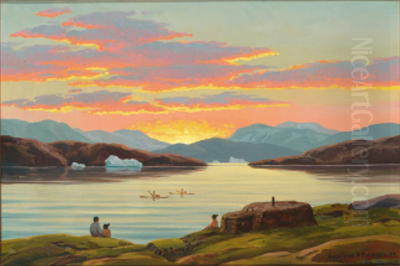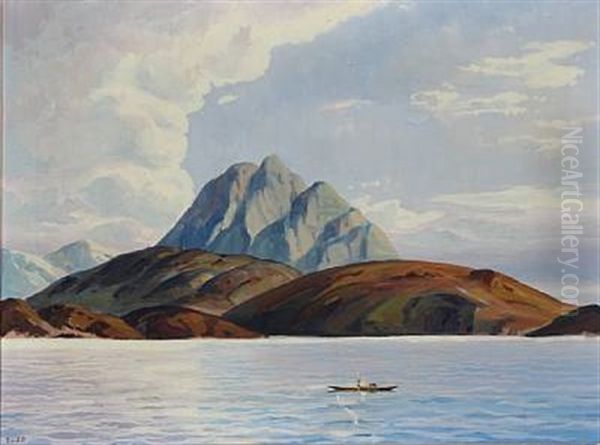
Emanuel A. Petersen (1894-1948) stands as a significant figure in Danish art history, primarily celebrated for his extensive body of work depicting the landscapes, people, and unique atmosphere of Greenland. Active during the first half of the 20th century, his paintings offered many Europeans their first visual encounters with this vast and remote Arctic land. His work serves not only as artistic expression but also as a historical record, capturing Greenland's essence in an era before photography became the dominant medium for documentation. Petersen's dedication to his subject matter resulted in a prolific output that continues to shape perceptions of Greenlandic identity and environment.
Early Career and Artistic Foundations
Before dedicating his artistic life to the Arctic, Emanuel A. Petersen received foundational training in a different, though related, field. His initial education was in the art of stage scenery painting. This background likely honed his skills in creating atmosphere, managing large compositions, and understanding the interplay of light and form, elements that would become crucial in his later landscape work.
Following his training in theatrical arts, Petersen transitioned into a role more directly connected to fine arts. He worked for a period at the prestigious Royal Copenhagen Porcelain Manufactory (Den Kongelige Porcelænsfabrik). Here, he served as a marine painter, focusing on depictions of the sea and ships. This experience undoubtedly deepened his understanding of water, sky, and the specific quality of northern light, further preparing him for the challenges of capturing the unique environment of Greenland.
The Lure of the North: Journeys to Greenland
Petersen's deep and enduring fascination with Greenland began to take shape in the early 1920s. This passion would define the majority of his artistic career. He embarked on numerous expeditions to the island, starting in 1921 and continuing frequently until 1935. During this decade and a half, his travels were extensive, covering vast swathes of the immense territory.

These were not mere sightseeing trips; they were immersive experiences. Petersen aimed to understand and capture the soul of Greenland. He traversed its coastlines and ventured into its fjords, observing the dramatic interplay of ice, rock, water, and the ever-changing Arctic light. His motivation extended beyond personal artistic fulfillment; Petersen held a conviction that sharing the beauty of Greenland through his art could foster a stronger connection and understanding between Greenland and Denmark.
Artistic Style: Harmony, Light, and Observation
Emanuel A. Petersen developed a distinct artistic style characterized by several key elements. Perhaps most notably, his work is renowned for its masterful capture of light. He paid meticulous attention to the way sunlight interacted with the Greenlandic environment – reflecting off glaciers, filtering through mist, illuminating the surfaces of water, and casting long shadows across the snow. This focus on luminescence gives his paintings a unique atmospheric quality.
While depicting a landscape often perceived as wild and dramatic, Petersen's style leaned towards harmony and a certain idealized beauty. Art historians note that his approach resonates more with the Danish "Golden Age" (Guldalderen) painters, such as Johan Thomas Lundbye or Vilhelm Kyhn, who emphasized balance, order, and a sense of cultivated nature, rather than the raw, untamed, and sometimes dangerous sublime often found in High Romanticism. Petersen sought a harmonious aesthetic even amidst the stark Arctic scenery.
His subject matter was varied, though consistently focused on Greenland. He painted grand vistas of fjords and icebergs, dramatic sunsets and sunrises painting the snow and sky with color, and quieter scenes of settlements nestled in the landscape. Figures often appear in his work, sometimes as small elements providing scale against the vastness of nature, depicting daily life, hunting, or travel by kayak or dogsled. He also created portraits aiming to capture the distinctiveness of the Greenlandic people.
Petersen was exceptionally prolific. Throughout his career, he is estimated to have created between 2,000 and 3,000 paintings. A significant portion of this output was produced on commission, suggesting a strong market demand for his depictions of Greenland. This high volume also means that variations of certain popular scenes exist, painted with slight differences for different patrons. His primary medium was oil paint, applied to canvases of various sizes.
Representative Works and Common Themes
While a comprehensive list of his thousands of paintings is difficult to compile, certain themes and specific works stand out. One titled work mentioned in historical context is "Polar bear in a snowstorm," indicating his engagement with the Arctic fauna and dramatic weather conditions. However, much of his reputation rests on the collective impact of his recurring subjects.
His representative works often include expansive landscapes featuring majestic icebergs floating in deep blue or turquoise waters. He frequently depicted the dramatic light conditions of the Arctic, capturing the low sun of winter, the vibrant hues of dawn and dusk over snowy expanses, and the clear, sharp light of summer days. Scenes featuring wildlife, particularly reindeer traversing snowy terrain, were also common motifs in his oeuvre.
Human presence is consistently documented. Paintings often show small coastal settlements with characteristic houses, kayaks pulled up on shore, and figures engaged in daily activities. He painted Greenlandic people in traditional attire, including women wearing the distinctive tall hats, sometimes as focal points in portraits, other times integrated into broader scenes of community life. These works collectively build a visual narrative of Greenland as Petersen experienced and interpreted it.
Shaping Perceptions: Petersen and the Image of Greenland
In the decades Petersen was most active, his paintings played a crucial role in disseminating images of Greenland to a wider audience, particularly in Denmark and Europe. Before photography became easily reproducible and widely circulated, paintings like Petersen's were primary sources for visualizing this distant part of the world. His work helped shape popular perceptions of the Arctic landscape and its inhabitants.
His perspective, however, was inevitably that of an outsider, a European artist interpreting a culture and environment different from his own. While aiming to capture beauty and foster connection, his depictions are often seen through a lens of romanticization. This approach sometimes simplified or idealized the complexities of Greenlandic life and the often harsh realities of the Arctic environment.
Later visual documentarians, particularly photographers like Jette Bang, offered different perspectives. Bang's photographs, often taken at closer range and with a more ethnographic focus, provide a contrasting view, emphasizing detail and a more modern, less overtly romanticized sensibility. Comparing Petersen's paintings to later photographic work highlights the evolution of how Greenland has been represented visually. Petersen's work remains significant, but it is understood today as one specific, albeit influential, interpretation.
Context, Contemporaries, and Artistic Milieu
Emanuel A. Petersen worked during a period of significant activity in landscape painting across Scandinavia, although the provided historical sources do not detail specific collaborations or direct artistic exchanges between Petersen and his contemporaries. His style, as noted, shows affinities with the preceding Danish Golden Age painters like Lundbye and Kyhn, suggesting an awareness of this national artistic tradition.
His focus on dramatic northern landscapes also places him in a broader context of Nordic art. Painters in Norway, such as Erik Pauelsen and Lorentzen (first name not provided in source), were also known for depicting their own country's striking natural scenery. While direct interaction isn't documented in the source material, Petersen's work can be seen as part of a wider Scandinavian interest in national landscapes and identity during the 19th and early 20th centuries.
The available information emphasizes Petersen's individual focus on Greenland. His repeated journeys and prolific output suggest a singular dedication to this subject matter. While he was undoubtedly aware of broader artistic trends, his career appears largely defined by his personal engagement with the Arctic, rather than active participation in specific art groups or documented collaborations with other painters of his generation.
Reception, Controversy, and Critical Evaluation
Emanuel A. Petersen's work has received considerable attention, both during his lifetime and posthumously, but critical evaluation has been complex and sometimes divided. On one hand, his paintings have been widely appreciated for their aesthetic appeal, their skillful rendering of light and atmosphere, and their value as historical documents of Greenland. His ability to evoke the beauty of the Arctic landscape resonated strongly with audiences.
However, his legacy is also subject to critique and controversy. Nivi Christensen, director of the Nuuk Art Museum, has pointed out that Petersen's work might be over-represented in Greenlandic art institutions and related publications. This dominance, Christensen suggests, potentially overshadows the contributions of indigenous Greenlandic artists and presents a narrow, Danish-centric view of "Greenlandic art," blurring the lines around what defines the nation's artistic identity.
Furthermore, the romanticized and harmonious nature of his depictions has drawn criticism. Some argue that his focus on beauty and harmony, aligned with the Danish Golden Age aesthetic, sometimes led to inaccuracies in geographical representation and glossed over the harsher aspects of Arctic life. His perspective has been described as reflecting a European tendency to view non-European cultures as "the other," fitting them into familiar aesthetic frameworks rather than fully embracing their unique context. There's ongoing debate about whether his work, while visually appealing, inadvertently served Danish colonial interests by presenting a picturesque and unthreatening image of Greenland. A minor point noted in sources mentions skepticism about the practicality of the painting equipment he reportedly carried on his travels, perhaps hinting at questions regarding the on-location authenticity of some works, though this remains speculative.
Legacy and Art Historical Position
Despite the complexities and ongoing discussions surrounding his work, Emanuel A. Petersen holds an undeniable place in Danish and Greenlandic art history. His primary importance lies in his role as a visual chronicler of Greenland during a specific historical period. He created an extensive and largely unparalleled painted record of the island's landscapes, environment, and people before the widespread adoption of photography changed the nature of visual documentation.
His paintings are now considered valuable historical artifacts, offering insights into Greenland's past and how it was perceived by Europeans in the early 20th century. They serve as a "photographic witness" in the absence of actual photographs for many of the scenes and moments he captured. His dedication resulted in a vast body of work that continues to be studied and exhibited.
Significant collections of his paintings are held in institutions, most notably the Nuuk Art Museum (Nukiga Kunstmuseum) in Greenland, which houses approximately 150 of his works. His paintings are also found in private collections and other museums focusing on Arctic subjects globally. While the source material does not mention specific awards granted to Petersen during his lifetime, his enduring presence in museum collections and the continued interest in his work testify to his lasting significance.
Conclusion: A Painter of Arctic Light
Emanuel A. Petersen dedicated his artistic life to capturing the unique character of Greenland. Through thousands of oil paintings, he explored its dramatic landscapes, the subtle play of Arctic light, and the lives of its inhabitants. His style, rooted in a Danish tradition emphasizing harmony and beauty, presented Greenland through a specific, often romanticized lens. While his work has faced criticism regarding representation and potential inaccuracies, it remains a vital and extensive visual record from a pivotal time in Greenland's history. Petersen's legacy is that of a prolific and passionate interpreter of the North, an artist whose work continues to evoke the profound beauty and enduring allure of Greenland's icy realms.